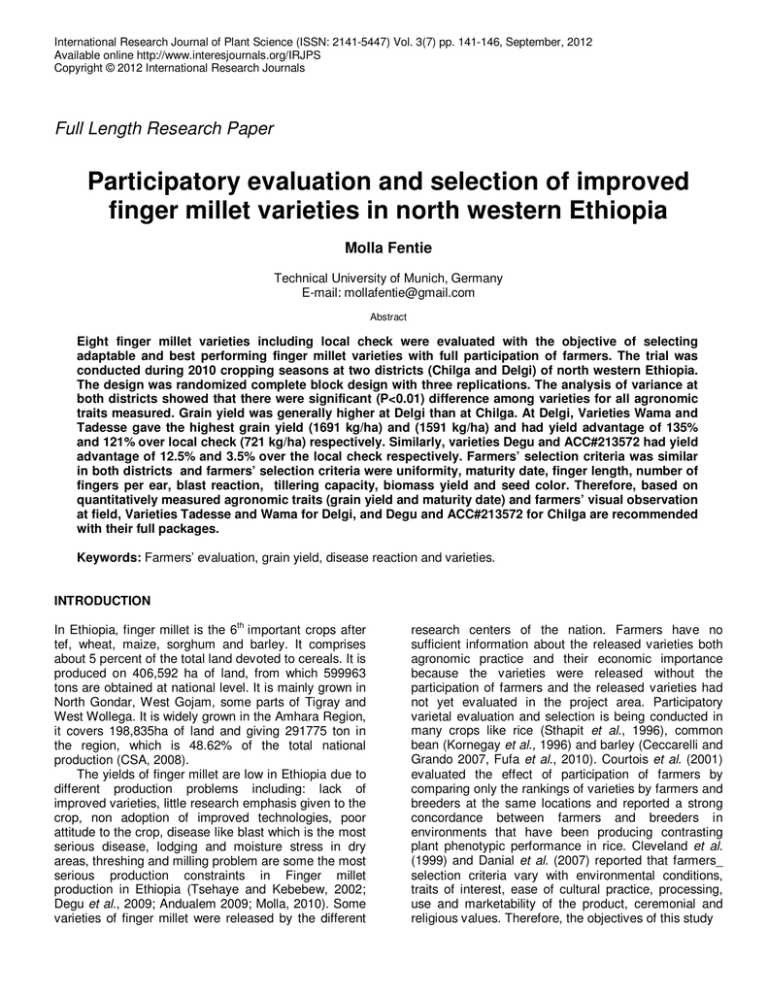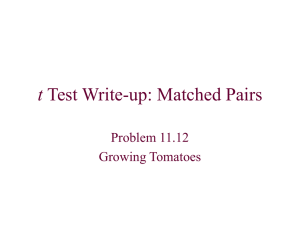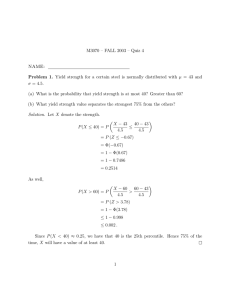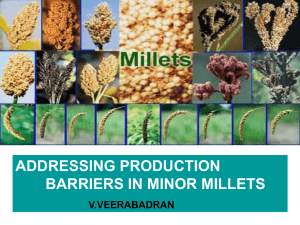Document 14258416
advertisement

International Research Journal of Plant Science (ISSN: 2141-5447) Vol. 3(7) pp. 141-146, September, 2012 Available online http://www.interesjournals.org/IRJPS Copyright © 2012 International Research Journals Full Length Research Paper Participatory evaluation and selection of improved finger millet varieties in north western Ethiopia Molla Fentie Technical University of Munich, Germany E-mail: mollafentie@gmail.com Abstract Eight finger millet varieties including local check were evaluated with the objective of selecting adaptable and best performing finger millet varieties with full participation of farmers. The trial was conducted during 2010 cropping seasons at two districts (Chilga and Delgi) of north western Ethiopia. The design was randomized complete block design with three replications. The analysis of variance at both districts showed that there were significant (P<0.01) difference among varieties for all agronomic traits measured. Grain yield was generally higher at Delgi than at Chilga. At Delgi, Varieties Wama and Tadesse gave the highest grain yield (1691 kg/ha) and (1591 kg/ha) and had yield advantage of 135% and 121% over local check (721 kg/ha) respectively. Similarly, varieties Degu and ACC#213572 had yield advantage of 12.5% and 3.5% over the local check respectively. Farmers’ selection criteria was similar in both districts and farmers’ selection criteria were uniformity, maturity date, finger length, number of fingers per ear, blast reaction, tillering capacity, biomass yield and seed color. Therefore, based on quantitatively measured agronomic traits (grain yield and maturity date) and farmers’ visual observation at field, Varieties Tadesse and Wama for Delgi, and Degu and ACC#213572 for Chilga are recommended with their full packages. Keywords: Farmers’ evaluation, grain yield, disease reaction and varieties. INTRODUCTION In Ethiopia, finger millet is the 6th important crops after tef, wheat, maize, sorghum and barley. It comprises about 5 percent of the total land devoted to cereals. It is produced on 406,592 ha of land, from which 599963 tons are obtained at national level. It is mainly grown in North Gondar, West Gojam, some parts of Tigray and West Wollega. It is widely grown in the Amhara Region, it covers 198,835ha of land and giving 291775 ton in the region, which is 48.62% of the total national production (CSA, 2008). The yields of finger millet are low in Ethiopia due to different production problems including: lack of improved varieties, little research emphasis given to the crop, non adoption of improved technologies, poor attitude to the crop, disease like blast which is the most serious disease, lodging and moisture stress in dry areas, threshing and milling problem are some the most serious production constraints in Finger millet production in Ethiopia (Tsehaye and Kebebew, 2002; Degu et al., 2009; Andualem 2009; Molla, 2010). Some varieties of finger millet were released by the different research centers of the nation. Farmers have no sufficient information about the released varieties both agronomic practice and their economic importance because the varieties were released without the participation of farmers and the released varieties had not yet evaluated in the project area. Participatory varietal evaluation and selection is being conducted in many crops like rice (Sthapit et al., 1996), common bean (Kornegay et al., 1996) and barley (Ceccarelli and Grando 2007, Fufa et al., 2010). Courtois et al. (2001) evaluated the effect of participation of farmers by comparing only the rankings of varieties by farmers and breeders at the same locations and reported a strong concordance between farmers and breeders in environments that have been producing contrasting plant phenotypic performance in rice. Cleveland et al. (1999) and Danial et al. (2007) reported that farmers_ selection criteria vary with environmental conditions, traits of interest, ease of cultural practice, processing, use and marketability of the product, ceremonial and religious values. Therefore, the objectives of this study 142 Int. Res. J. Plant Sci. were to evaluate and select improved finger millet varieties which are high yielding, disease resistance (blast) and early maturing with the participation of farmers in north western Ethiopia. MATERIALS AND METHODS The experiment was conducted during 2010 main cropping season at two districts (Chilga and Delgi) in north western Ethiopia. Eight varieties including the local check were included in the study. The trial was laid down in randomized complete block design (RCBD) with three replications. Each experimental plot had five rows of five meter length spaced at 0.75m with a gross 2 area of 18.75 m . Planting was done by hand drilling at seed rate of 15 kg ha-1. Fertilizer was applied at the rate of 41/46 kg/ha N and P2O5 respectively. Half of the total nitrogen and total phosphorus were applied at the time of planting while the remaining nitrogen was applied at the time of tillering. To reduce border effect, data were taken from the central three rows. Weeding and other management practices were done as required. Farmers were participated in evaluation and selection of improved finger millet varieties at maturity stage through farmer research extension group (FREG). Farmers set their selection criteria and ranking of varieties according to their setting criteria. The rank sum method each trait for each variety was used to rank varieties based on farmers’ selection criteria. The value of each trait has equal weight. SAS and SPSS statistical softwares were used to compute ANOVA and Pearson coefficients correlation, and spearman rank correlation respectively. RESULTS AND DISCUSSION At Delgi, the analysis of variance indicated that there were significant (P<0.01) difference among varieties for number of fingers per plant, days to maturity, plant and finger length, grain and biomass yield. Among varieties, Wama and Tadesse matured early compared to other varieties which will, best fit the early finger millet production system. Baruda was late mature type and best fit for late maturing finger millet production system. The mean grain yield value indicated that Wama followed by Tadesse gave the highest grain yield (1691 kg/ha) and (1591kg/ha) respectively while the lowest grain yield was recorded by Baruda (696 kg/ha). Varieties Wama and Tadesse gave the highest grain yield (1691 kg/ha) and (1591 kg/ha) and had yield advantage of 135% and 121% over local check (721 kg/ha) respectively. Varieties ACC#213572 (92.40 cm) and Baruda (56.60 cm) were the tallest and shortest plant height respectively. The mean values of biomass yield ranged from 6.4 ton/ha (Baruda) to 10.51 ton/ha (Wama) (Table 1). At Chilga, the analysis of variance exhibited that there were significant (P<0.01) difference among varieties for number of fingers per plan, days to maturity, plant and finger length, grain and biomass yield. The highest and lowest grain yield was obtained by varieties Degu (1447 kg/ha) and Baruda (766 kg/ha) respectively. Varieties Degu and ACC#213572 had yield advantage of 12.5% and 3.5% over the local check respectively. The local check (8.67) followed by Degu (8.46) gave the highest biomass yield while the lowest is recorded by Baruda (4.32 ton/ha).The mean values of finger length and plant height ranged from 4.83 cm (Baruda) to 9.03cm (ACC#213572) and 43.73 cm (Baruda ) to 73.13 cm (local check) respectively. Among varieties, Boneya, Tadesse and ACC# 213572 matured early compared to other varieties which will, best fit the early finger millet production system. Baruda was late mature type and best fit for late maturing finger millet production system. The number of finger per plant ranged from 4.93 (Tadesse) to 7.6 (ACC#213572) (Table 2). Similar results were reported by Tsehaye and Kebebew, (2002); Fakrudin et al.,( 2004); Bedis et al., (2006); Bezaweletaw et al., (2006); Andualem, (2008) ; Chrispus, (2008). They stated the presence of genetic variability in yield and yield related traits of finger millet germplasm. In both locations, the Pearson coefficients of correlation analysis indicated that there were significant and positive correlation plant height with grain yield and biomass yield (Table 3). This is in agreement with the finding of (Wolie and Dessalgn, 2011) in finger millet. The presence of negative and significant correlation between grain yield and days to maturity was reported by Bezaweletaw et al.(2006) in finger millet and Singh et al.(1990) in chickpea. However, finger length and number of finger per plant did not show any significant correlation with grain yield (Table 3). The full participation of farmers was key tool for evaluation and adoption of improved varieties. Famers identified their selection criteria of improved varieties; accordingly they listed as follows: yield related traits (effective number of tillers, number of fingers per ear, plant height, finger length, stand and uniformity at maturity, days to maturity and biomass yield), seed color and blast disease reaction. The selection criteria were the same in both locations. These may be due to common trait of interest, ease of cultural practice, processing, and cultural value. This is in agreement with findings of Cleveland et al. (1999) and Danial et al. (2007). They reported that famers’ criteria vary with environmental conditions, traits of interest, ease of cultural practice, processing, use and marketability of the product, ceremonial and religious values. Accordingly, farmers selected varieties for their district. Fentie 143 Table1. Mean values of yield and yield related traits in finger millet during 2010 at Delgi Varieties Tadesse ACC#213572 Degu Boneya Baruda Wama BRC-029-1 Local check Mean CV (%) Days to Maturity e 118 cd 123 126bc 122de 140a 118e de 120 129b 124.42 1.13 No. of finger per plant cd 5.87 10.27a 6.73bcd 7.73b 7.03bc 5.13d bcd 6.27 7.13bc 7.02 8.78 Plant Height (cm) ab 80.27 92.40a 82.93ab 91.53a 56.60c 86.40ab bc 70.00 72.20bc 79.04 8.28 Finger Length (cm) b 4.60 8.93a 8.27a 4.13b 7.83a 5.40b b 3.80 7.40a 6.30 10.03 Grain yield (kg/ha) a 1591 ab 1120 736b 1573a 696b 1691a ab 1096 b 721 1153 18.59 Biomass (ton/ha) ab 9.71 ab 9.81 8.80abc 8.16abc 6.40c 10.51a bc 7.57 abc 8.37 8.67 10.83 Farmers Rank 1 2 5 4 8 3 7 6 Researchers Rank 1 5 6 3 8 1 3 7 Table2. Mean values of yield and yield related traits in finger millet during 2010 at Chilga Varieties Tadesse ACC#213572 Degu Boneya Baruda Wama BRC-029-1 Local check Mean CV (%) Plant height(cm) 67.13ab 72.77a 71.17a 71.43a 43.73c 72.23a 63.50b 73.13a 66.88 5.94 Numbers of finger per plant 4.97c 7.60a 6.17bc 6.33ab 6.80ab 4.93c 6.65ab 7.47ab 6.36 11.35 Tadesse, ACC#213572 and Wama at Delgi and ACC# 213572, Local check and Degu at Chilga are selected in descending order for the respective district (Table 5). The farmers selected varieties and finally collected grain yield is highly correlated. This is in agreement with the finding of Courtois et al. (2001). Therefore, Farmers participation was very important in variety evaluat- Finger length (cm) 5.13bc 9.03a 8.50a 4.83c 8.53a 6.25b 5.10bc 8.27a 6.96 9.1 Days to maturity 137cd 139bcd 145b 135d 155a 142bc 143bc 145b 143 1.62 Grain yield (kg/ha) 1062cd 1331ab 1447a 915de 766e 1216abc 1190bc 1286abc 1151 10.74 Biomass Yield(ton/ha) 5.86bc 7.24ab 8.46a 7.22ab 4.32c 6.58ab 5.90bc 8.67a 6.78 16.42 ion and selection for specific environment. CONCLUSION AND RECOMMENDATION The analysis of variance at both districts showed that there were significant (P<0.01) difference among varieties for all agronomic traits measured. Farmers Rank 4 1 3 7 8 6 5 2 Researchers Rank 4 6 2 5 8 1 4 2 Grain yield was generally higher at Delgi than at Chilga. At Delgi, Varieties Wama and Tadesse gave the highest grain yield (1691kg/ha) and (1591kg/ha) and had yield advantage of 135% and 121% over local check (721kg/ha) respectively. Similarly, varieties Degu and ACC#213572 had yield advantage of 12.5% and 3.5% over the local check respectively. 144 Int. Res. J. Plant Sci. Table3. Pearson coefficients of correlation for yield and yield related traits at Delgi and Chilga Number of fingers per plant Number of fingers per plant Plant height Finger length Days to maturity Grain yield Biomass yield 0.28ns 0.48* 0.22ns -0.17ns 0.02ns Plant height Finger length Days to maturity Grain yield Biomass yield -0.00ns 0.50** -0.12ns 0.13ns -0.45** 0.38** 0.10ns 0.61** 0.26ns -0.08ns 0.18ns 0.69** 0.11ns -0.22ns 0.62** -0.03ns -0.64** 0.48* 0.65** 0.56** -0.05ns 0.02ns -0.65** -0.56** 0.66** *, ** . Correlation is significant at 0.05 and 0.01 levels respectively. ns –non significant. Lower: Delgi and upper: Chilga Table 4. The spearman’s rank correlation coefficients of farmers and researchers scores with quantitatively measured traits in eight finger millet varieties at Delgi and Chilga Days to maturity Days to maturity 0.92 Biomass yield 0.53ns Farmers Biomass yield Researchers Farmers -0.14ns -0.04ns -0.07ns 0.04ns 0.52ns 0.83* .43ns .69ns ** Grain yield Researchers Grain yield ** 0.99 0.65ns * 0.786 0.69ns ** 0.952 * 0.81 0.54ns * 0.83 .24ns 0.69ns *, ** . Correlation is significant at 0.05 and 0.01 levels respectively. ns –non significant. Lower: Delgi and upper: Chilga. Wama and Tadesse at Delgi and Boneya at Chilga were found to be the earliest to mature whereas Baruda was the late maturing of all the varieties in both locations. Farmers’ selection criteria was similar in both districts and farmers’ selection criteria were uniformity in terms stand and maturity, maturity date, finger length, number of fingers per year, blast reaction, tillering capacity, biomass yield and seed color. Accordingly, farmers selected varieties for their location. Tadesse, ACC#213572 and Wama at Delgi and ACC# 213572, Local check and Degu at Chilga are selected in descending order for the respective localities. Therefore, based on quantitatively measured agronomic traits and farmers’ visual observation at field, Varieties Tadesse and Wama for Delgi and, Degu and ACC#213572 for Chilga are recommended with Fentie 145 Table5. Farmers evaluations, merits, drawbacks and over all rank given for each variety during 2010 cropping season at Delgi and Chilga Chilga Variety Tadesse Merits Good grain filling and tolerance to blast Acc#213572 Boneya Very good tillering capacity, high effective tiller and biomass, high numbers of fingers and long fingers Large number of fingers, effective tiller and high straw biomass - Baruda - Wama - Degu BRC-029 Local Delgi Draw backs Short finger length, low tillering capacity and low straw biomass Susceptible to blast Rank 4 Merits broad fingers, tolerance to water logging, early maturing Draw backs Its fingers quite short Rank 1 1 Large number of fingers, long fingers and high straw biomass Susceptibility to blast and late maturing 2 weak stalk and susceptible to blast 3 - late maturing, short finger length 5 short and low number of fingers ,poor tillering capacity low number of fingers ,short plant height, poor tillering capacity and late maturing short and Low number of fingers, poor tillering capacity 7 Long plant height, early maturing and water logging tolerance - Poor stand and tillering capacity 4 long maturity ,low tolerance to cold temperature ,very short plant height Poor tillering ,lack of uniformity at maturity 8 high straw biomass and good tillering capacity, long fingers short and Low number of fingers 5 7 Very good tillering capacity, long fingers, high number of fingers, high straw biomass Susceptible to blast 2 Short plant height , low number of fingers, late maturing and poor tolerance to water logging Susceptible to blast, late maturing their full package REFERENCE Andualem W ( 2008). Characterization, Evaluation and Variability for Grain Yield and Related Traits of Finger Millet [Eleusine coracana (L.) Gaerthn.] Germplasm. M.Sc Thesis 8 6 Good grain filling capacity, long plant height, water logging tolerance and high biomass - Long plant height , poor tillering Presented to the School of Graduate Studies of Haramaya University. Bedis MR, BN Ganvir, Patil PP (2006). Genetic variability in finger millet. Journal of Maharashtra Agricultural University 31:369-370. Bezaweletaw K, P Sripichit, W Wongyai, Hongtrakul V ( 2006). Genetic variation, heritability and path-analysis in Ethiopian finger millet [Eleusine coracana (L.) Gaertn)] landraces. Kasetsart Journal Natural Sciences 40:322-334. 3 6 Ceccarelli S, Grando S ( 2007). Decentralized-participatory plant breeding: an example of demand driven research. Euphytica 155, 349-360. Chrispus OA (2008). Breeding Investigation of Finger millet Characteristics including blast disease and striga resistance in Western Kenya. A thesis submitted in partial fulfilment of the requirements for the degree of Doctor of Philosophy (PhD) in Plant Breeding, University of KwaZulu-Natal Republic of South Africa. 146 Int. Res. J. Plant Sci. Cleveland DA, D Soleri, Smith SE (1999). Farmer Plant Breeding From a Biological Perspective: Implications for Collaborative Plant Breeding. CIMMYT Economics Work Paper No. 10, Mexico, D.F. CIMMYT. Courtois B, B Bartholome, D Chaudhary, G McLaren, CH Misra, NP Mandal, S Pandey, T Paris, C Piggin, K Prasad, AT Roy, RK Sahu, VN Sahu, S Sarkarung, SK Sharma, A Singh, HN Singh, ON Singh, NK Singh, RK Singh, S Singh, PK Sinha, BVS Sisodia, Takhur R (2001). Comparing farmers and breeders rankings in varietal selection for low-input environments: a case study of rainfed rice in eastern India. Euphytica 122, 537-550. CSA (2008). Agricultural sample survey report on area and production for major crops (Private peasant holdings meher season). The FDRE Statistical Bulletin 439, Vol.1. Addis Ababa, Ethiopia. Danial D, J Parlevliet, C Almekinders, Thiele G (2007). Farmers_ participation and breeding for durable disease resistance in the Andean region. Euphytica 153, 385-396. Degu E, Adugna A, Tadesse T, Tesso T (2009). Genetic resources, breeding and production of millets in Ethiopia.In: New approaches to plant breeding of orphan crops in Africa. Proceedings of an International Conference, Bern, Switzerland, 19-21 September 2007. Fakrudin B, RS Kulkani, HE Shashidhar, S Hittalmani (2004). Genetic diversity assessment of finger millet, Eleusine coracana (Gaertn) germplasm through RAPD analysis. Bioversity International Newsletter 138:50-54. Fufa, F, S Grando, O Kafawin, Y Shakhatreh, Ceccarelli S (2010). Efficiency of farmers’ selection in a participatory barley breeding programme in Jordan. Plant breeding 129,156-161. Kornegay J, JA Beltran, Ashby J (1996). Farmer selections within segregating populations of common bean in Colombia: Crop . improvement in difficulty environments. In: P. Eyzaguirre, and M. Iwanaga (eds), Participatory Plant Breeding, 151—159. Proceeding of a workshop on participatory plant breeding, 26–29 July 1995, Wageningen, The Netherlands. IPGRI, Rome, Italy. Molla F (2010). Genotype x Environment Interaction and Stability Analyses of Yield and Yield Related Traits of Finger Millet (Eleusine coracana (L) Gaertn) Varieties in North Western Ethiopia. M.Sc Thesis Presented to the School of Graduate Studies of Haramaya University. SAS Institute (2002). SAS System for Windows Release 9.2. Inc, Cary, NC, USA. Singh KB, Bejiga G, Malhotra RS (1990). Association of some characters with seed yield in chickpea collections. Euphytica 49: 83-88 SPSS (2003). SPSS for Windows Release 12.0.1. SPSS Inc, Chicago, IL, USA. Sthapit BR, KD Joshi, Witcombe JR ( 1996). Farmer participatory crop improvement. III. Participatory plant breeding, a case study for rice in Nepal. Exp Agric 32, 479-496. Tsehaye Y, Kebebew F (2002). Morphological Diversity and geographical Distribution of Adaptive Traits in Finger millet (Eleusine Coracana (L) Gaerthn. subsp. coracana (Poaceae) Populations from Ethiopia. In: Journal of Biological Sciences, 1(1): 37-62 (Mogessie Ashenafi, eds).Addis Ababa, Ethiopia. Wolie A, Dessalegn T (2011). Correlation and path coefficient analyses of some yield related traits in finger millet (Eleusine coracana (L.) Gaertn.) germplasms in northwest Ethiopia. African J. Agricultural Res. Vol. 6(22), pp. 5099-5105





